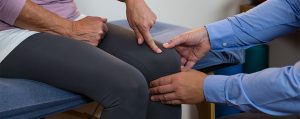Will Cracking Your Knuckles Cause Arthritis?
Posted on by Shelia M. Tenny, OTR/L, CHT
Knuckle cracking or popping is a habit that many people develop, despite being told it could cause arthritis or harm, but is that really accurate? Long story short, no it does not cause damage in a healthy person. Many start cracking their knuckles as a nervous habit, tick, restlessness, or they’ve noticed the looser feeling in their joints.
(more…)
Strength Training Considerations for Youth Athletes
Posted on by Tara Hackney, PT, DPT, OCS, KTTP
As young kids’ participation in sports increases, strength training in youth athletes also continues to be seen more frequently. Strength is an important part of daily life as well as for participation in sports. Strength training at a young age can be beneficial for coordination, flexibility, and bone density as well as general health. We know that preventative exercise (prehabilitation) focuses on strengthening muscle groups that are overused in specific sports (i.e. rotator cuff for overhead throwing athletes) and it may reduce overuse injuries in these athletes. Increasing incidence of strength training may lead to questions about safety and how much training children should be doing for their age and level.
(more…)
How to Fall Correctly to Prevent Hand Injuries
Posted on by Lizzy Miotti PT, DPT
As a physical therapist and hand therapist, one of the biggest concerns I hear from my patients is that they are worried they are going to fall and hurt themselves. It is not uncommon for a therapist to be treating injuries that resulted from a fall. The upper extremity (shoulder through the fingers) is a common place for injuries to occur following a fall as many will use their hands to brace their fall in order to protect their face or head. This type of fall is called a F.O.O.S.H or a fall on an outstretched hand. This blog will briefly look into common injuries of the upper extremity with a fall and will talk about ways to prevent these injuries.
(more…)
3 Conditions You Didn’t Know Dry Needling Can Help
Posted on by Athletico
As is true with many things in life, there may be more contributing to your pain than meets the eye. In fact, the point of pain may not be the source. Muscles throughout the body can create myofascial trigger points, often referred to as “knots.” These palpable tender spots are a group of muscle fibers that maintain a semi-contracted state for too long. The fascia, which is a non- contractile tissue, covers nearly every muscle fiber, can also be a part of this point restriction. These restrictions can be very tender to touch and can have a greater influence on how the entire muscle activates. Through years of research, medical professionals have been able to map common referral patterns for each muscle.1
(more…)
4 Tips to Prevent Achilles Pain or Injury
Posted on by Kathleen Warner PT, DPT, OCS
Achilles pain or injury can prevent itself in the form of tendinopathy (i.e. tendinitis or tendinosis), or the more critical Achilles tendon tear or rupture. The Achilles tendon is the tendon to the gastroc and soleus, which together are known as the calf muscles. The role of a tendon is to transfer the force from the contracting muscle to the intended joint of movement. Together these muscles plantarflex the ankle joint, or point the foot downwards. This action creates the force needed to push the ground away and help propel the body forwards (or upwards) when we are walking, running, or jumping. The Achilles tendon is the strongest tendon in the body, and the gastroc and soleus are the primary ankle plantar flexor muscles.
(more…)
Best Exercises to Stay Fit After 50
Posted on by George Zakharia, DPT
The body is one resilient structure that changes based on the loads you put on it to protect itself from damage. This is the entire reason why we get stronger when we lift and better endurance when we move. However, if we stay sedentary, the body finds no need to get stronger or build endurance. Therefore, exercise may just be the best medicine to keep you strong, moving, and healthy, especially if you’re 50 or older. Read on to discover the best exercises to stay fit and healthy after 50!
(more…)
The Mental & Physical Sides of Running: What Keeps Me Going
Posted on by Matthew Klayman, PT, DPT, OCS, Cert. DN
I don’t have to be the first to tell you that this has been a tough year for everyone emotionally, mentally and physically. Sticking to a healthy routine has never been more important. Throughout the last year, running has always been an outlet for me. Through tough, lonely, and cold days where it was an effort to even get out of the house, running has always put my mind and body at ease, providing stress relief and happiness, even if for a short period of time.
(more…)
How Long Is Too Long? When To Seek Help for Pain
Posted on by Brandon Bowers, PT, DPT, Astym Cert.
The majority of individuals have experienced some form of physical pain or injury over the course their lives. Some adopt the “no pain, no gain” mentality while others seek medical attention right away. Is it ok to “work through the pain”? What about taking a “wait and see” approach prior to seeking medical care? How long is too long to wait prior to receiving medical care for pain?
(more…)

